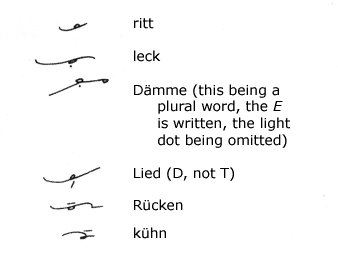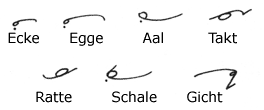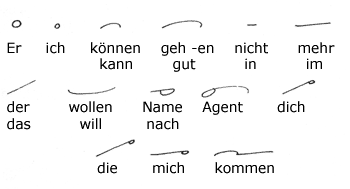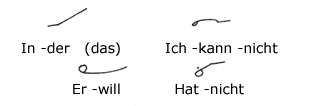| Home Reporting A Judge’s Charge Dupraw’s Notes Sklarew’s Notes Zoubek’s Notes Pre-Anniversary Description Reference Material Brief Form List Anniversary Description Reading Material Reference Material Brief Form List Most-Used Phrases Simplified Description Brief Form List Dupraw on Note Size Diamond Jubilee Description Brief Form List Expert Brief Form List Series 90 Description Brief Form List Centennial Description Brief Form List Taquigrafía Gregg Gramálogos German Gregg Manual Esperanto Gregg Manual Brief Forms Irish Gregg Manual Gregg Group Gregg Learning Forum Ms. Letha’s SH Site Shorthand³ Omniglot's Entry Wikipedia's Entry Stenospeed Dictation Practice Andrew Owen |
| 1. Only sounds are represented in Gregg Shorthand—all silent letters are omitted. Thus, one does not write Thron but tron; not hohl but hol; not Carl but karl; not Rock but rok; not Fall but fal (short A); not Ruhm but rum; and so on. Double consonants are not written except where the belong to different syllables and are therefore sounded separately. One L is written in Fallen and one P in Lippe, but two R's are represented in verrechnen. 2. It is not
necessary to show the majority of the inflexions of adjectives,
verbs, etc. The following rules should be carefully noted:
(b) Singular nouns ending in E lose this letter. Nouns in the singular are inflected only for the genitive. Plural nouns are written in full, but the (additional) dative N is omitted.
(c) In verbs a final E is omitted except when it occurs in the third person of the imperfect indicative or subjunctive.
(d) The ending EN or N is always omitted. 3. The consonants are nearly all arranged in pairs, according to their affinity of sound, and are distinguished by a difference in length.
(a) The curves are
formed from an elliptical figure: (b) These strokes are written forward; the T and D upward from the line of writing. (c) The G is always the G in words such as gehen, never the G in foreign words such as Genie (The character for this G will be given later). G at the end of words and syllables is sometimes pronounced CH, as in bröckelig, but the stroke as given at the head of this paragraph is always used. (d) Similarly, D at the end of words is sometimes pronounced T, but D is written notwithstanding. Tod is an example. (e) The H dot is placed just above the vowel which immediately follows. 4. The vowels are represented by the circle (in two sizes, large and small) and by hooks. They are written into the shorthand form at the point where they occur in the spoken word. 5. A Vowel Markings
(a) The large circle represents the vowel sound (the A) in Kamm; with a light dot underneath, it represents the vowel A in kam, the AH in Mahl, or the AA in Aal; with a short dash, it represents the Ä in käme, the EE in leer, the EH in kehren, or the E in dem. (b) The dots and dashes are seldom used; they become necessary occasionally in isolated or unfamiliar words. 6. E Vowel Markings
The small circle has four values: Standing alone it represents the I in nimm; with a light dot, the E in denn or the Ä in fällig; with a short dash, the IE in Kiel; with a short light horizontal line struck over it, it represents the Ü in Rügen and Müller. The following are the rules to be observed for the writing of the circles: (a) Inside curves standing alone or joined to straight strokes without forming an angle. (b) Between two reverse curves the circle is turned on the back of the first curve. (c) When joined to straight strokes (and when coming between two straight strokes in the same line) the circle is written in the direction of movement of the hands of the clock. (d) When two characters join with an angle, the circle is written outside the angle. 8. Word-Signs
A large proportion of all written and spoken language is made up of a comparatively few words. The above forms, which are termed "word-signs," should be committed thoroughly to memory. 9. Phrasing
Simple words when they form natural grammatical phrases should be joined, but awkward joinings must be carefully avoided. The above are a few examples. 10. Punctuation
should be given proper attention. The period is expressed
by - Next Page - |
|
Preface About Gregg Shorthand Editor's Note A Talk with the Beginner The Alphabet Chapter I Unit 1 Unit 2 Unit 3 Chapter II Unit 4 Unit 5 Unit 6 Chapter III Unit 7 Unit 8 Unit 9 Chapter IV Unit 10 Unit 11 Unit 12 Chapter V Unit 13 Unit 14 Unit 15 Chapter VI Unit 16 Unit 17 Unit 18 Chapter VII Unit 19 Unit 20 Unit 21 Chapter VIII Unit 22 Unit 23 Unit 24 Chapter IX Unit 25 Unit 26 Unit 27 Chapter X Unit 28 Unit 29 Unit 30 Chapter XI Unit 31 Unit 32 Unit 33 Chapter XII Unit 34 Unit 35 Unit 36 |








